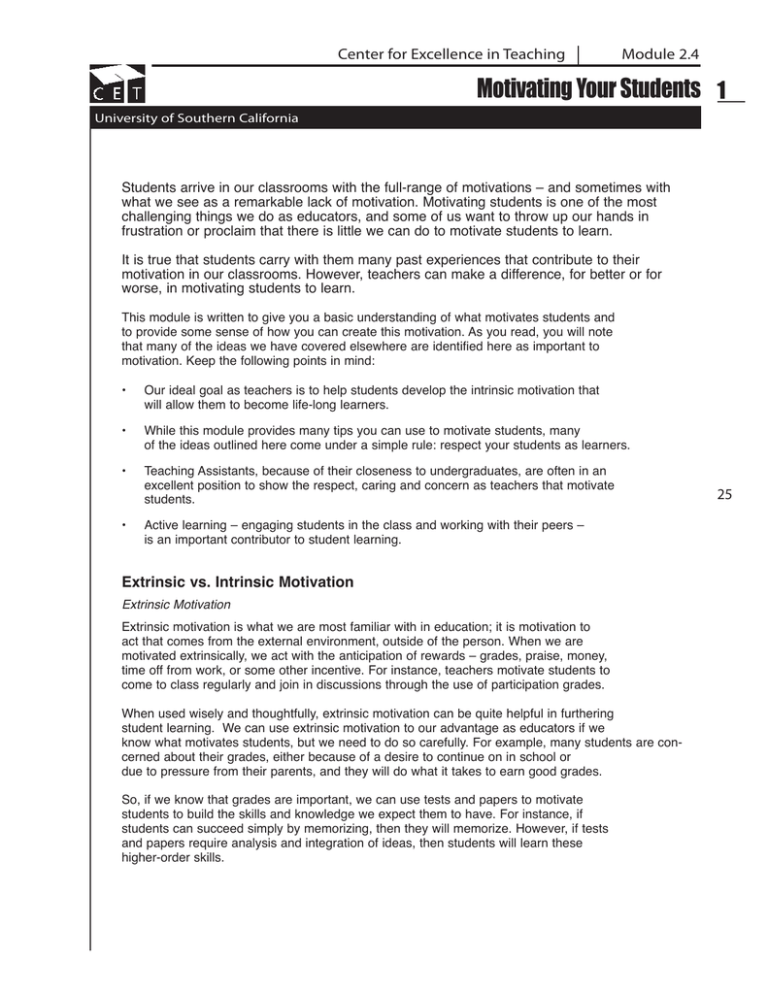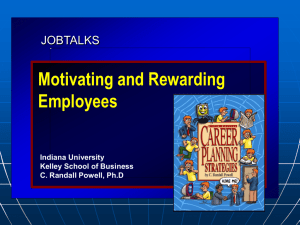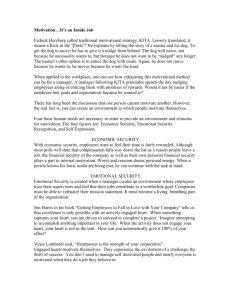Motivating Your Students 1 Center for Excellence in Teaching Module 2.4
advertisement

Center for Excellence in Teaching Module 2.4 Motivating Your Students 1 University of Southern California Students arrive in our classrooms with the full-range of motivations – and sometimes with what we see as a remarkable lack of motivation. Motivating students is one of the most challenging things we do as educators, and some of us want to throw up our hands in frustration or proclaim that there is little we can do to motivate students to learn. It is true that students carry with them many past experiences that contribute to their motivation in our classrooms. However, teachers can make a difference, for better or for worse, in motivating students to learn. This module is written to give you a basic understanding of what motivates students and to provide some sense of how you can create this motivation. As you read, you will note that many of the ideas we have covered elsewhere are identified here as important to motivation. Keep the following points in mind: • Our ideal goal as teachers is to help students develop the intrinsic motivation that will allow them to become life-long learners. • While this module provides many tips you can use to motivate students, many of the ideas outlined here come under a simple rule: respect your students as learners. • Teaching Assistants, because of their closeness to undergraduates, are often in an excellent position to show the respect, caring and concern as teachers that motivate students. • Active learning – engaging students in the class and working with their peers – is an important contributor to student learning. Extrinsic vs. Intrinsic Motivation Extrinsic Motivation Extrinsic motivation is what we are most familiar with in education; it is motivation to act that comes from the external environment, outside of the person. When we are motivated extrinsically, we act with the anticipation of rewards – grades, praise, money, time off from work, or some other incentive. For instance, teachers motivate students to come to class regularly and join in discussions through the use of participation grades. When used wisely and thoughtfully, extrinsic motivation can be quite helpful in furthering student learning. We can use extrinsic motivation to our advantage as educators if we know what motivates students, but we need to do so carefully. For example, many students are concerned about their grades, either because of a desire to continue on in school or due to pressure from their parents, and they will do what it takes to earn good grades. So, if we know that grades are important, we can use tests and papers to motivate students to build the skills and knowledge we expect them to have. For instance, if students can succeed simply by memorizing, then they will memorize. However, if tests and papers require analysis and integration of ideas, then students will learn these higher-order skills. 25 Module 2.4 2 Motivating Your Students Intrinsic Motivation If extrinsic motivation comes from without, then intrinsic motivation comes from within. Intrinsically motivated learners want to learn because they are curious, they want to improve, they seek knowledge, and learning gives them satisfaction. McKeachie (1999) notes that this form of motivation nurtures and encourages the habit of lifelong learning. As students leave school, external motivators for learning, such as grades and praise, are replaced by long-term goals and less immediate rewards. Intrinsic motivation encourages us to continue learning regardless of what rewards come our way. How Do We Motivate Students? Some students worry about grades; others need to satisfy a course prerequisite. Still others want to learn and explore ideas. In fact, many students are probably motivated to learn and to succeed by a combination of intrinsic and extrinsic elements. The key for us as teachers is to understand what we can do to build students’ motivation to learn in our classroom, and to nurture the intrinsic motivation that will guide future learning. We know that students respond positively to three elements in most classes (Davis, 1993): 26 • • • A well-organized course; A teacher who is enthusiastic about the material and about teaching; A teacher who shows he or she cares about the students and their learning. The first point is very important to motivation and is covered in other modules. The remainder of this module, then, will address the questions of enthusiasm (also discussed to some degree in the module on communication) and demonstrating care for students and student learning. Below are some basic actions you can take to motivate students in your classroom. You will note, as you read, that these ideas are interconnected; they are part of a complete effort to build relationships with and motivate students. • Communicate high but attainable expectations and goals. Most students want to be challenged and feel that they are directing their energies toward a worthwhile experience. This means that they will work to achieve challenging goals if they view the goals as within their reach. True, some students are motivated by the fear of the daunting “killer test,” but you will lose more students than you gain, and those you gain will not retain their motivation outside of the classroom. • Give students the chance to succeed. High standards for student work are fine, but it is important to make those standards clear and give students a chance to discover and meet them. You may want to consider the following suggestions to help students succeed: • Give a test, quiz or paper early in the semester, return it to students, and give them a chance to retake or rewrite it. This lets them learn the standards and have a chance to improve. • Rather than giving a few large tests and assignments, give smaller more frequent ones. This makes the material students must learn more manageable and gives them more chances to succeed. Module 2.4 Motivating Your Students 3 • Increase the difficulty of tests and assignments over time. Tell students you are doing this to help them learn your expectations and develop knowledge and skills to draw upon. • Give early, immediate and comprehensive feedback. The idea of giving feedback is closely related to giving students a chance to succeed. In order to learn, students need and want to know the standards and expectations you have for their performance. Thorough comments from you on tests and assignments show students what is needed to succeed. But your comments do more than just this: they also show the students that you respect them and are committed to their learning. Students notice when a teacher does (or does not) put forth effort in making comments on student work, and they respond accordingly. • Create a learning community in your classroom. McKeachie (1999) notes that interaction, particularly with peers, is an important motivator for many students. There are several easy steps you can take to create an environment where students see themselves as part of a community of learners rather than as isolated individuals. • Reward success publicly. This does not need to be an elaborate effort. Thank students for their comments, compliment good points by saying “good point,” and refer back to individual students for their contributions when you can. • Share exemplary work with students. Copy, distribute (without names and with permission) and discuss outstanding papers or assignments. This helps students see your standards and it recognizes students who do outstanding work. • Use collaborative/cooperative learning groups. Students respond to interaction with their peers. Putting students in groups can therefore promote their learning. • Know your students and their interests. If you know who your students are and what they are involved in, you can adjust your class to connect with their interests. This can help them see the relevance of the material and motivate them to engage in class. For instance, one professor teaches a course on French culture in which most of the students are Business or International Relations majors. Upon learning this information, the professor created a project where students worked in groups of three to determine the feasibility of locating a major shopping store in various locations in France. • Use a variety of teaching methods. No matter how gifted you are as a teacher, using the same method to teach each class can become monotonous – for you and for the students – causing the students to lose interest and motivation. When possible, vary your methods within and between classes. Break students into groups, give mini-lectures, have class discussions, use case studies, stage a debate, etc. This variety engages and motivates students. • Avoid individual competition. Competition in and of itself is not necessarily a negative. Pitting groups against one another in games that help them learn the material can be a useful motivator. However, you should avoid creating a situation where students see themselves in direct competition with one another for grades. • Try to prevent too much anxiety from developing among students. Most of us tend to work a little harder or a little longer when we are worried about an important test or a big event and want to make sure we succeed. However, too much anxiety can make us want to give up and not even try. This is why it is important to have reasonable goals and expectations and give students a chance to succeed. 27 Module 2.4 4 Motivating Your Students The Unmotivated Student If you have taught, you know what it feels like to look out at students’ faces and see some of them who just do not look engaged in class. We often want to look at them and say, “I give up. I can’t motivate you!” When you feel this way (and you will), it is important to remember that, for students, our course is one small component of their lives (Luce, 1990). They are taking other courses, making friends, participating in activities, working to pay their way through school, and even taking care of families. In short, they are leading complex lives that affect how much energy and attention they can give to our classroom. It is important to remember that there is a limit to just how much we can actually motivate students. But it is also important not to stop trying because you may find that, just as you become tired and frustrated, whatever pressures have been pulling the student down will eventually ease. And when this happens, they will appreciate the efforts you have made. Sources Center for Excellence in Teaching. (1999). Teaching Nuggets. Los Angeles: University of Southern California. 28 Davis, Barbara Gross. (1993). Tools for Teaching. San Francisco: Jossey-Bass. Luce, Ronald W. (1990). Motivating the Unmotivated. Innovation Abstracts, 15 (9). McKeachie, J. Wilbert. (1999). Teaching Tips: Strategies, Research and Theory for College and University Teachers (10th ed.). Boston: Houghton Mifflin Company. UCLA Office of Instructional Development. (1997). The TA Handbook 1997-98. Los Angeles: University of California. TIPS FOR... Motivating and Supporting Students • State clearly and explicitly what students need to do to receive an “A” in your course. • Get to class early and talk with your students about what they are doing in school, what they hope to learn, and what they are really enjoying. • Find simple ways (a comment to the class, a remark to a student after class, an e-mail) to recognize student contributions and excellent work. • Give students examples of ways in which class concepts relate to “real world” matters.



